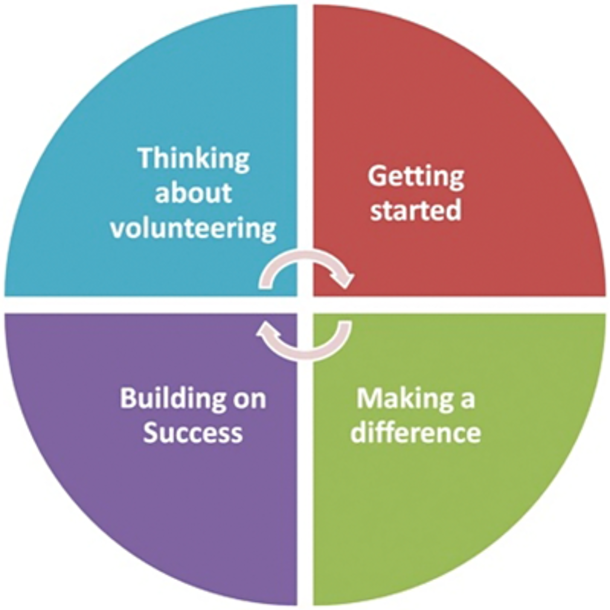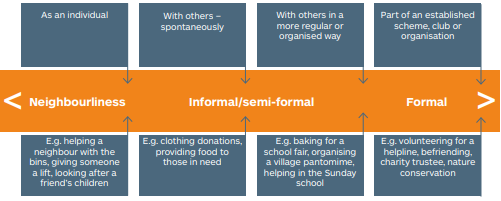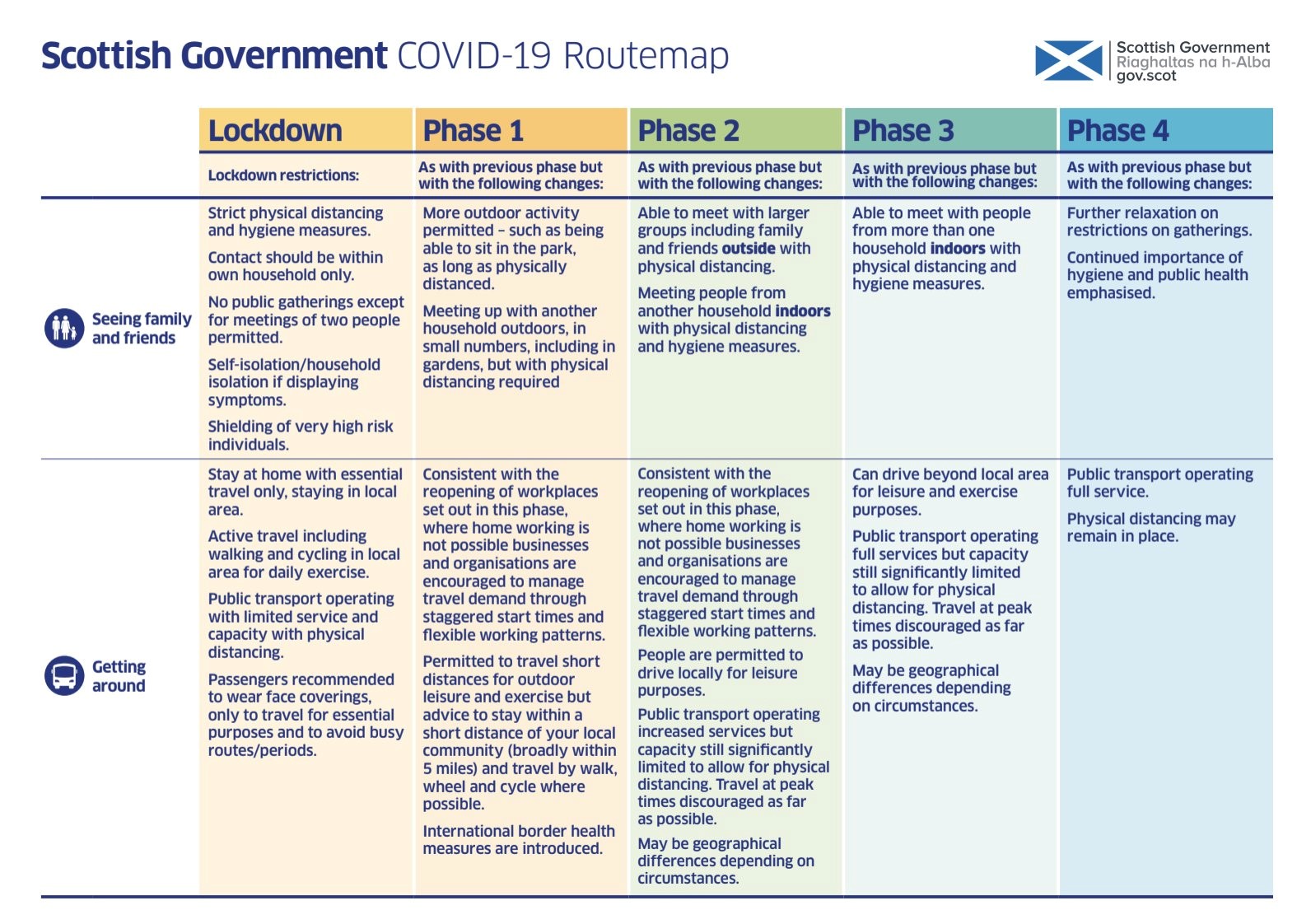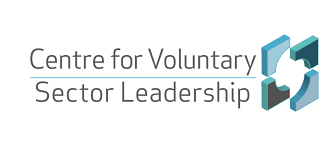Keeping Volunteers Safe: Restarting your Volunteer Programme
| Site: | OpenLearn Create |
| Course: | Keeping Volunteers Safe |
| Book: | Keeping Volunteers Safe: Restarting your Volunteer Programme |
| Printed by: | Guest user |
| Date: | Thursday, 22 January 2026, 12:45 AM |
Description
This course is about the essential things you need to consider to ensure a positive experience for individuals returning to engage in volunteering following suspension of programmes in response to Covid-19. The overall aim is to help you prepare your volunteers, organisation and colleagues to return to supporting volunteer involvement in your work. It was developed with input from volunteers, volunteer-involving groups and organisations, volunteer practitioners and trainers. This input has given us the volunteers’ perspective and the volunteers’ ‘voice’ that we hope you will find helpful throughout the course.
1. Introduction

Figure 1: Volunteer Scotland (All Rights Reserved)
The course will introduce the key questions that groups or organisations should reflect on as they think about re-starting their volunteer programmes. The course will help you prepare your volunteers, groups or organisations and colleagues to return to supporting volunteer involvement. However, the current situation and how individuals and group or organisations respond to COVID-19 allows us to start to explore the broader topic of “Keeping Volunteers Safe”.
The course has been developed with input from volunteers, volunteer-involving groups and groups or organisations, volunteer practitioners and trainers, specifically the Volunteer Scotland Action Learning Group. The COVID-19 situation is very fluid, and therefore, this course will be organic, it is not a complete or finished course, and we will develop its content over the next few months as the current situation changes. (Please remember to adapt this information into your local context and seek out the relevant government advice for your locality of operations).
1.1. About this course
The course has been inspired by the recent COVID-19 experiences. There is no doubt that COVID-19 has and will continue to have a significant impact on the operations of charities and volunteering. For example, a report for the Charity Regulator in Scotland OSCR suggested in June 2020 found 51% had lost fundraising income, 66% of groups with more than 11 staff had furloughed staff, and 32% had reduced the number of volunteers they had, and this appears to be an emerging pattern throughout the UK.
As a response to these challenges there is a wide range of support available for group or organisations during this COVID 19 period, including an evolving set of resources at SCVO, Scottish Government, UK Government, Age UK, NHS Scotland Inform, H&S COVID 19 page, NCVO, WcVA, Volunteer Now, at Volunteer Scotland and with health information about COVID 19 on the Open University OpenLearn website and more specific material about leadership and management in the context of a pandemic.
In many ways, we live in quite an information-rich world, and one of the issues is making sense of what applies to us in our context. The course aims to introduce the essential things you might need to consider to ensure a positive experience for individuals initially returning to engage in volunteering or scaling up your volunteer programme following a period of suspension or low levels of activity.
Please remember this course is related most closely to the Scottish context. Still, the overarching principles can be applied to the rest of the UK and the international community, in conjunction with your local and national governments most up to date policy and advice.
1.2. About our Approach

Figure 2: Volunteer Management Model (Volunteer Scotland, All Rights Reserved)
All courses developed by Volunteer Scotland are based on the volunteer management model (Figure 2) a model which represents the perspective of a volunteer as they pass through the different phases of their volunteering ‘journey’. Volunteer Scotland developed the model with volunteers and those who support volunteers.
This course covers the first two quadrants “thinking about volunteering” and “getting started”, in the model above. In each section, we will ask you to consider some key issues that we feel are relevant to our current situation and the wellbeing of volunteers. You will explore and reflect on these in your context and then develop an appropriate action plan for your situation.
Throughout the course, you will encounter the phrase ‘appropriate to your context’. This course recommends that at every stage, how you involve, manage or support your volunteers needs to be proportionate. For example, where formality is required, it should be provided; where it is not required, then formal procedures and structures are not appropriate. When a volunteer is returning, it may be that a formal briefing report is not appropriate for all volunteers. However, you still want to have a plan about how to communicate. It may be something written or video summary of what to expect when they return to volunteer with you. Please look at Involving Volunteers for more guidance on how to develop practices that are proportionate within your practice.
1.3. Who is the course for?
This course is for individuals who support volunteers, specifically those with a member of staff or leader who organises or manages a volunteer programme. While it is aimed at paid staff and reflects the spirit of volunteer management, it also draws on ideas from community engagement and less formal contexts. Therefore, we feel that this course will be useful to a broad range of people, from volunteers who support other volunteers, to community workers who involve community members, to paid volunteer practitioners. It is related most closely to the Scottish context. Still the overarching principles can be applied to the rest of the UK and the international community, in conjunction with your local and national governments most up to date policy and advice.
1.4. What will you learn?
We understand that not everyone who supports volunteers is a paid member of staff and that not all volunteer practice happens in big group or organisations. However, this course has been developed to support the functions to create a safe and positive volunteer experience, and we hope it will also be useful in smaller less formal group or organisations and community groups.
By the end of the course you will have:
- Considered if and when it is appropriate to scale up or fully restart your volunteer programme;
- Considered what needs to happen before and during any restart to your volunteer programme;
- Drawn on the core values and guidance around volunteer practice to keep volunteers safe;
- Reflected on how what can be learnt from the COVID-19 experience.
1.5. How you will learn
As volunteering is a broad subject and volunteering takes place in a broad spectrum, this course aims to be accessible, appropriate and adaptable to your situation. To help with this, the course uses a ‘reflective practice’ approach to learning, which encourages participants to observe, reflect and act.
‘Reflective practice’ is becoming increasingly common in a range of contexts. At its core is the sense that reflecting on what you do makes you better at what you do. As volunteering takes place in so many different settings and takes many different forms, this is not a course that shares the right answer but encourages you to ask the right questions. Several different models of reflective practice exist, and you can learn more about these in the OpenLearn course Becoming a reflective practitioner.
The course will ask you to record your reflections on practice in an Action Plan. Once you click on the link you can download the template and use it to help you structure your reflections and build them into your work for the broader group or organisation activities.
Although the learning materials are online, this does not mean that all learning will take place online. You will learn through applying ideas and asking questions within your context. The activities are written from the perspective of an individual working their way through the material. However, it is worth exploring how you might involve others in this learning and how to apply this reflective practice in a group setting.
The course will also signpost you to further resources at the end of each section. Where relevant, reference materials have been included throughout the course to act as a gateway to further reading and learning.
1.6. Introducing the Case Studies
Throughout the course you will see quotes from groups, organisations and volunteers, all talking about their experiences of improving volunteering practice. These reflections will help to support your critical reflection. Some we mention once, and they are introduced in the text. Others we return to throughout the course, and these are detailed below.
Volunteer Scotland Action Learning Group is a peer support network for volunteer practitioners
Sustrans Scotland provides advice, support and funding that makes it easier for people to walk and cycle for everyday journeys.
Royal Blind Scotland’s largest vision impairment group or organisation. Our vision is to see a community in which blind and partially sighted people, including those who have other disabilities, are fully included and lead fulfilling lives
Kilmaurs Gala Day started in 1922, and the current Gala Committee and a group of local community members restarted the event in 2006, after a period of inactivity. They are a constituted group supported by the local community, businesses, Kilmaurs Primary School and East Ayrshire Council.
1.7. How to use this course
The course is aimed at volunteer practitioners who are likely to be dealing with complex and competing demands on their attention and their time. It is not a plan or a map of how to restart a volunteer programme, instead, it directs your attention to resources that are likely to be important, shares critical questions and how other practitioners have responded to those questions. The course is a work in progress, use it to help you identify and work through the issues in your context, and do come back and revisit it as circumstances change.
2. What is volunteering

Figure 3: Volunteer Hands (Public domain)
It is worth
considering this question before we go any further as, as we each have our own
understanding of what volunteering is, The UN General Assembly
definition describes volunteering as ‘Three basic criteria can be identified to
distinguish volunteering from other types of human activity:
- It is not undertaken primarily for financial gain. Because voluntary action is not rewarded with a wage or salary, it is generally cost-effective, although not cost-free;
- It is undertaken of one’s own free will. The decision to volunteer may be influenced by peer pressure or personal feelings of obligation to society but, in essence, the individual must be in a position to choose whether or not to volunteer;
- It benefits a third party or society at large. Actions that benefit only the person who volunteers or that cause harm to society do not meet this criterion.
2.1. Volunteering is a Choice
The Scottish Government’s Volunteering for All – A National Framework, states that
“Volunteering is a choice. A choice to give time or energy, a choice undertaken of one’s own free will and a choice not motivated for financial gain or for a wage or salary”.
Informal volunteering can include individual activities such as helping a neighbour, or group activities such as taking a friend’s children to school, without involving a group. Then there are forms of community action or social participation that can include residents’ committees or a community centre, where groups and group or organisations will often be involved to enable the voluntary activity. There is also formal volunteering, where you commit to giving your time to a group, such as fundraising in a local charity shop (see Figure 4).

Figure 4: The Scottish Government’s Volunteering for All – A National Framework (Crown Copyright, with permission)
2.2. Types of Volunteering

Figure 5: Volunteer Word Cloud (Public Domain)
There are a wide variety of volunteering roles, opportunities and contexts. This course is principally focused on formal volunteering and those managing formal volunteer opportunities, although the reflective practice would be suitable for all to use who involve volunteers. For more information on informal volunteering,you may want to read Volunteering ‘below the radar’?. Volunteer Scotland has produced a Volunteer Charter in conjunction with the STUC. The 10 principles of the Volunteer Charter underpin our approach in this course.
For further information on the subject of “What is volunteering” you may be interested in our online companion course Involving Volunteers
Please be aware that during the COVID-19 pandemic all governments and assemblies have produced specific information on volunteering opportunities. You can refer to the UK government website for guidance and support with regard to volunteer placements, rights and expenses. You may also want to review COVID 19 information from Volunteer Scotland, NCVO, WcVA and Volunteer Now.
3. Reopening your volunteer programme

Figure 6: Thinking About Volunteering (Volunteer Scotland, All Rights Reserved)
The title of this section feels presumptuous. It suggests that the volunteer programme ought to restart. However, to make an informed choice about if, how and when volunteers will return or scale up to full volunteering, you ought to reflect on these two steps:
- First, you will reflect on the plans you want to deliver by involving volunteers and understanding how volunteers see themselves in relation to those plans;
- Second, you will ask a series of questions to help you assess whether it is time for volunteers to return and if so how
These steps are not sequential, they involve a dialogue, and you will need to move between volunteers and their needs, the group or organisation and its capabilities and changes in the world around you. Before you can do this, you need to be clear what you want individuals to do and ask what individuals would like to do and how they would like to contribute. It means understanding what your group or organisation plans to deliver, and whether your volunteers can fit into that plan safely and effectively. For example, those individuals within the over-70 group need to take additional care, and this is described on NHS inform as
”strictly follow physical distancing measures...their household and other contacts should also strictly follow physical distancing advice.”
The guidance does not preclude older people from volunteering in line with the easing of lockdown relevant to your group or organisation and the places you operate. However, the interpretation of the NHS inform advice becomes critical. Here we use the example of the over-70 group. Age UK offers advice on how people over 70 can volunteer safely. As we know, some volunteering roles come with higher risks than others. For example, volunteering in a hospital will be riskier than over-the-phone befriending. Sometimes it won’t be obvious how risky your role is. The following questions can help you to think through the risks:
- Will you have face-to-face contact with people you don’t live with?
- Will you be in contact with the same people each time or different people? The more people you come into contact with the higher the risk of transmission.
- Will you be around people who may be more exposed to COVID-19? For example, health professionals?
- Will you be able to socially distance from other people?
In other areas, the restrictions may provide opportunities for group or organisations to reflect on who volunteers with them and why. Kilmaurs Gala Committee, after reviewing the COVID-19 situation in March 2020, the committee decided to follow the public health and Scottish Government guidelines. This resulted in their Summer activities and volunteering roles to be suspended until 2021. As the the guidelines and information was adapted the committee was able to adapt some activities such as, instead of village car treasurer hunt it is now a walking treasure hunt (following social distancing rules) and a quiz night was moved to an online platform. Youth volunteering charity Project Scotland used the opportunities offered by everyone being at home and online to develop a programme to support disabled people to volunteer online. This included people with disabilities offering streaming free exercise classes online. You can find more details on the Volunteer Scotland blog page ‘Sports volunteering and coronavirus’ and ‘Is there a role for disabled volunteers in the response to Covid-19?’.
3.1. Is this the right time
Groups or organisations looking to restart their volunteer programme from a stopped or scaled back position need to consider internal and external drivers before confirming whether they are ready to restart their volunteer programme or fully scale up. Restrictions placed on citizens and group or organisations by Government are in the process of being lifted and amended. In Scotland, the Scottish Government has published a Route Map to support decision making.
See figure (7) below, which sets out the different phases as we move from Lockdown to Phase 4 (the New Normal).

Figure 7: Scottish Government COVID-19 Route Map (Crown Copyright, with permission)
Finding your group or organisation on the route map is not straight forward. For example, if you are a UK-wide group or organisation, this adds a level of complexity as advice is different in different countries of the UK. You then need to look at how local restrictions and national Government implement the different recovery phases in relation to your operations. For volunteer practitioners, there is the additional pressure of thinking through what sector they fit into and the different roles that volunteers play in different parts of the group or organisation. The Volunteer Scotland cross-sector Action Learning Group people have shared concerns about:
- Which volunteer roles or tasks within a group or organisation apply to which phase of the route map?
- Has your group or organisation issued specific guidance relevant to your activities and or locality?
- Does your group or organisation expect you to make this decision, or does that responsibility rest elsewhere?
- Have your group or organisation considered updating policies and procedures? For example, the challenges around difficult conversations may include instances where a volunteer or staff member makes a complaint regarding an individual not following guidelines, e.g. social distance.
As a volunteer practitioner or a person who supports volunteers, you will need to assess three overlapping areas. You need to match your group or organisation’s requirements for volunteers with the number of volunteers potentially available to carry out those activities and any restrictions that may apply as we move forward out of lockdown and enter each recovery phase.
3.2. Activity 1
|
Activity 1 |
|
Please take some time to consider the following points and if appropriate update your Action Plan: |
|
Ask yourself these questions:
Feedback for this activity is on the next page. |
3.3. Activity 1 Feedback
One of the issues for volunteer practitioners is that while we all share the experience of supporting volunteers, the way they are supported varies between and within contexts. For example, many charities operate shops often staffed by volunteers who will fall under retail guidance. The BBC reports on the concerns within the sector about what happens as shops re-open; of course in some places retail charity has been open for some time. This article in the Guardian follows the experience of one shop in London, from sorting through the piles of donated clothes from people at home having a clear-out to thinking through how customers might move around cramped spaces.
However, other parts of the operations may fall under different categories like personal care. It is crucial to look carefully at the different roles volunteers perform in the group or organisation to ensure you can develop appropriate structures or processes to support volunteer activity to return.
3.4. Asking the Right Questions
In this section, we consider whether it is appropriate to restart (or for everyone to restart) the volunteer programme. In the next activity, the focus is on what decision-making tools can help you understand whether it is the right time to resume volunteer activity. Volunteer Scotland have listened to people across the sector who have or are planning to return, below is Top Ten Questions people have asked.
Top Ten Questions
1. Is the volunteering role still relevant and or needed?
2. How do you know which volunteers are ready to return?
3. Will individuals need specific support or input to return to their roles?
4. Can all roles be resumed? Do those roles need to be changed?
5. What can you learn from the return of staff to their roles; have you been given guidance by your board or senior management?
6. What do you need to feedback to your leaders?
7. What kinds of tasks do volunteers do?
8. Where do these take place?
9. What will you need to put into place to ensure social distancing and other safety measures?
10. What are the drivers for restarting your volunteer programme?
These questions are strategic in that they ask you to consider:
- Where do volunteering and the roles they perform sit in the wider context for your group or organisation?
- Is it about delivering services or something else?
- How do they relate to your group or organisational values?
- How does it provide purpose and engagement for volunteers and staff?
- What about questions of economic sustainability if our organisations rely on volunteers to generate income?
3.5. The Decision Making Process
Making these
decisions are not easy. It is essential to take some time to consider:
- Who needs to be involved to make this happen
- How long is this activity likely to take;
- Whether you need any other kind of resource to achieve it?
Part of the values expressed in this course is that when a group or organisation is thinking about these strategic and operational questions, they remember that volunteering is freedom of choice. Individuals considering a return to volunteering need to think whether returning to an opportunity or an activity is going to be right for them.
Choices are based on a complex mix of practical concerns and more complex personal choices associated with our beliefs and values. Individuals may also have different interpretations of the government guidance, based on their health status, or that of their family members, their interpretation of any risks involved, and the level of risk with which they are comfortable.
Volunteers may also have experienced negative financial impacts, increased caring or working responsibilities, or bereavements which may delay their readiness to resume their usual role or impact on their emotional needs as they return.
Individuals can only make real choices if they have a clear understanding of what is expected of them, and what is expected of them in return. Remember that the Volunteer Charter confirms that volunteering should always be a choice that is freely made.
So far, you have considered two critical areas related to ‘restarting your volunteer programme’,
‘Is this the right time’ and
‘Asking the right questions’.
Having reflected on what is proportionate for your context, the next step is to use what you have recorded in your Action Plan so far to flesh out an action plan to help you make positive changes.
3.6. Activity 2
|
Activity 2 |
|
Please take some time to consider the following points and if appropriate update your Action Plan. Consider the following questions and sketch out a response |
Feedback for this activity is on the next page. |
3.7. Activity 2 Feedback
You might have spoken to your volunteers, or you may not have had the opportunity to do so. Either way, you probably thought about how different volunteers might expect different things. Some are probably keen to get back. For those mainly working outdoors like Sustrans, they found because their volunteering is outside,
“…most of their volunteers are keen to get out the house again!”
Others found more variation. For example, the Royal Blind has spoken with their volunteers and have discovered
“…that for the most part their volunteers tell us they are keen (some even impatient) to come back”.
However, even within the enthusiasm to get back and start making a difference, the Royal Blind found individuals were concerned about others, in particular the welfare of our older and otherwise COVID-19 vulnerable service users. Royal Blind found that while most were not concerned about themselves a
“…small number of volunteers have talked about their own existing health conditions and let us know that they will not be able to volunteer in-person for some time due to COVID-19”.
For Royal Blind, the main thing was to show they were listening and cared about the wellbeing of volunteers. What practitioners have told us that these conversations are not primarily about encouraging people to come back but about listening to volunteers experiences as part of the decision making process about whether the organisation is going to restart is the programme and whether volunteers are ready to come back.
3.8. Summary
So far the course has asked you to consider
- Working with and listening to volunteers as you explore why your group or organisation is resuming or scaling up its volunteer programme
- Working with others in your group or organisation to assess the benefits of involving volunteers will be, for both the individual and the group or organisation
It has suggested that returning to volunteering shares the same values and approach set out in the CVSL VS course Involving Volunteers. In particular, the idea of restarting as akin to going through the phases of “Being Ready” allowing volunteers to assess whether it is “Right for me” and listening to volunteers and responding to their needs.
|
Please take some time to consider the following points and if appropriate update your . Consider the following questions and sketch out a response |
|
You may have already spoken to volunteers, or even noted down that some are not ready to return, perhaps you have thought about doing a mini-induction. You might even be wondering that goes into that indication, before you go to the next section.
There is no feedback for this activity |
4. Adapting to Change: Roles and Responsibilities

Figure 8: Diverse Hands (Public Domain)
The previous section highlighted that volunteering is a choice, and people choose to volunteer for different reasons. In the course “Involving Volunteers,” we emphasised the idea that choices ought to be real, and that choice is informed by openness and transparency. Being open and transparent is not easy when things are changing quickly. Rather than focus directly on the changes this section shares questions and concerns about how to adapt to those changes and highlights areas to focus on:
The structures you might need to adapt or change to support the involvement of volunteers during the COVID 19 situation and recovery phases. This might include training and support, changes to leadership structures, reviews of formal guidance on safe working and volunteering practices, the opportunity to review progress and change as the situation evolves.
- Developing an awareness of the individual, collective and group or organisational responsibilities around health and safety, legislation and insurance and what action you must take before your programme restarts or scales up during the COVID-19 situation and recovery phases
4.1. Keeping your Volunteers Safe
You have a “duty
of care” to keep your volunteers safe. The “duty of care” has a range of different
parts to it; this section looks at Health and Safety for volunteers and risk
assessment. One of the issues for people supporting volunteers is that it is
not always clear where volunteers sit in a group or organisational and even
broader societal health and safety practices. The legislation is generally employee
focused, and volunteers are not employees. Thinking through how relevant
Health and Safety advice applies to your context means thinking about the
sector in which your group or organisations operates and the tasks volunteers
perform. Earlier, we used the example of volunteers in retail, the HSE advice
for retail still applies, for example, manual handling is still manual handling,
and the same information advice and guidance applies now. So the HSE advice for
Charity Shops Risk Assessment Tool
and is still valid.
However, while some of the risks have not changed, it is clear that others have changed. Risk management and safety specialist Cardinus has produced a useful checklist for group or organisations to consider when thinking about restarting operations. The resource is on the US site the structure; however, the approach is relevant across sectors.
Volunteer Scotland have produced a comprehensive risk assessment which can be adapted to suit your situation and will help you think through and manage risks in your context. Volunteer Scotland Coronavirus in the Workplace Risk Assessment
At an organisational level, you can use these tools to develop your approach. For example, Paths for All is a group that encourages people to be more active, and volunteers play an essential part in the development and delivery of activities. As well as developing a specific Risk Assessment tool, they also have guidance notes and support, which could be tailored to suit your situation.
While Health and Safety advice, legal and legislative frameworks remain broadly similar, please remember that during the COVID-19 period, Public Health messages change the nature of risk and safeguarding volunteers. We would encourage you to review this changing environment continually.
4.2. Activity 4
|
Activity 4 |
|
Please take some time to consider the following points and if appropriate update your Action Plan: |
Feedback for this activity is on the next page. |
4.3. Activity 4 Feedback
The critical thing to remember when resuming your volunteer programme is the risks to staff, volunteers and others. Groups or organisations can have very different risks, and so a risk assessment must be conducted. For Paths for All and Sustrans, the assessment and the management of risk is based on working outside. Outside activity was able to resume earlier as lockdown in the UK was eased. For other organisations, the challenges are very different.
For example, if your volunteers are inside, it changes when and how you might engage with volunteers. Volunteering Matters working with Volunteer Scotland have provided some useful templates in this regard for Community Groups or organisations as they look to start using buildings again. Other organisations are involved in working with families across a range of setting. For example, Chest Heart & Stroke Scotland are Scotland’s health charity supporting people and their families across Scotland with chest, heart and stroke conditions. Volunteers work in retail, and they have kindly shared their retail risk assessment which volunteer practitioners can adapt to allow volunteers to return to volunteering in retail premises safely.
All groups and group or organisations have a duty of care towards their volunteers to ensure that they will not be harmed while carrying out their role. You can take the time to talk through any measures your group or organisation has implemented to support their safety, and spend some time addressing any concerns that the volunteer may have. You should be confident that your volunteer can understand and commit to any additional safety precautions they are advised to take, as they also have a responsibility for their safety and the safety of others.
If a volunteer discloses that they are particularly at risk, shielding or otherwise vulnerable, your group or organisation may need to take a firm position on declining their involvement at that time. Volunteers can be signposted to the NHS Inform website for further advice.
4.4. Supportive Dialogue with Volunteers
If you find this challenging, imagine what it must be like for a volunteer who may be far less involved in the group or organisation. At the Action Learning Group, members shared ideas and experiences from their practice about how and when you will support your volunteers back into their roles or as your scale up your volunteering programme.
Active listening
Your volunteer may disclose sensitive information or want to tell you something that does not fit neatly in with the information you hope to gain from your conversation or communications. This could be something to do with their ability to return, or it could be an experience they have which might be of help to other volunteers or colleagues. Ensure your discussion is not rushed, and that you give the volunteer time to ask questions or check their understanding. Click here to read NHS Improvement’s information regarding Active Listening.
Supplementary information
If it’s a long conversation with lots of factual content, you
might wish to have a put together a briefing pack and have a follow-up email
ready. Volunteer practitioners have included guidance on new ways of working,
dates of critical meetings and details of additional training for volunteers.
You might also consider links to updated policies impacted by COVID-19. For
example, IT policy, lone working policy, health and safety policy, expenses
policy and expenses claim policy.
Think about how to record your conversation
Having a form that is appropriate for your context is a useful way to gather the information that you might need to collect from your volunteer. For example, basics like updated contact details and availability or if they have any new support needs as a result of COVID-19, or specific concerns about carrying out their role. The volunteer may disclose health information or personal information about their home lives. If you need to repeat your conversation at a later time, for example, if the volunteer is not ready to start yet, or the volunteer role has not fully resumed, it is useful to have a record of what was discussed for you to refer to at a later time.
When capturing any personal information about individuals, it is essential to ensure this complies with the Data Protection Act 2018 and your internal policies and procedures. It is good practice to share a copy of what you have recorded with the volunteer so they can give informed consent about the data you hold.
More information and guidance on this can be found on the Information Commissioner’s Office website.
4.5. Your Duty of Care: Support in Challenging Times
Both the volunteer and the person carrying out the discussion may be affected by things disclosed during discussions. If your group or organisation has an employee support service in place which includes volunteers, you may wish to remind the volunteer that it is available and share the contact details at the end of your discussion. In any case, you should remind the volunteer of your group or organisation’s duty of care towards its volunteers and confirm your willingness to deliver and maintain this. Contextualising this towards the COVID-19 environment will be critical. The resources listed in section 6.3 will help you with this. Staff carrying out the discussion may need to debrief with a colleague or the employee support service if they are exposed to distressing news. Where possible, the timing of these calls should allow for a short break in between.
We have referred to a conversation, but this may be a series of discussions over many platforms from text-based chats to phone or video calls to open-ended responses to surveys to which you reply, or other kinds of formal or informal communications. These are things you will be aware of any way in your practice. Here we simply highlight them as particular things to “look out for” when engaging with volunteers as we come out of lockdown.
In the next activity, you are asked to reflect on your context and consider what you need to ask your volunteers and anticipate where they might need guidance or support to return to their role.
4.6. Activity 5
|
Activity 5 |
|
Please take some time to consider the following points and if appropriate update your Action Plan: |
|
Think carefully about the kinds of conversations you might want to have about with volunteers, what is it you want to learn about them and their experience, what is it they need to know from you.
The feedback for this activity is on the next page. |
4.7. Activity 5 Feedback
Here are some of the things that volunteer practitioners shared with us:
Some of those things relate to knowing your volunteers and being interested in them and listening to their needs. For example, practitioners asked people to tell them about:
- Changes to their health status, family or other personal commitments, employment status or other volunteering participation – bearing in mind that these may change over time and without notice;
- What they have been doing in their time away from the group or organisation;
- Whether COVID-19 presents any perceived or actual impacts on their safety, including lone working, safeguarding measures in terms of exposure to the risk of transmitting or contracting COVID-19.
Some of the things relate directly to changes in the way volunteering within the group or organisation. For example:
- Whether the content of the role has changed or whether the timing or location of the role is different;
- If they will be carrying out the activity with people they know when they return, or different people;
- Whether the way they will be asked to do the role has changed due to COVID-19, including safety measures like social distancing or PPE;
- Whether any changes will be temporary or permanent and when they might be reviewed;
- Whether the timing or location of the role has been changed.
4.8. Support and Changing Roles
Part of planning involves thinking through all the different components of Volunteer Scotland’s Volunteer Life Cycle (see Involving Volunteers) to anticipate what happens. So imagine your volunteer has decided to renew their commitment to volunteering with your group or organisation. They need to know they are welcome and supported through the process of returning to their role, which may have changed as a direct or indirect result of COVID-19.
At the same time, volunteer practitioners may need to balance the needs of their volunteers against the needs of their group or organisation. As part of Volunteer Scotland’s Action Learning Group practitioners have shared concerns about:
- Group or organisational risks including financial, reputational and legal uncertainties;
- Concerns about health and safety, which includes their own and volunteers;
- The loss of the expertise brought by volunteers caused by further absence;
- Worries about the potential impact of prolonged isolation amongst volunteers who may be vulnerable;
- Issues around the purpose and function of your group or organisation where volunteers are part of a commitment to engaging with people as volunteers to improve their life circumstances.
You may wish to engage with your board or leadership team to help you navigate these concerns. You may also wish to spend some time preparing the volunteer for the possibility that returning to their role may not be a straightforward process. Both volunteers and group or organisations may experience a ‘start-stop’ process due to ongoing effects and risks of COVID-19. For the volunteer, this reflects the aspect of choice within the Volunteer Charter – what sounds good initially may not suit them in practice, and they may wish to step back again for a while.
Support also means being able to let go. It may be the case that you, or the volunteer, decide that now is not the right time for them to return, or they have decided to move on from your group or organisation. If this is the case, you can support them to return for a further conversation at an agreed time to resume their involvement at a later date or progress them through your usual leavers’ process. Their feedback will be valuable in considering the impact of COVID-19 on your volunteering programme when you come to evaluate this at a later time.
4.9. Training and Support
Those who
are returning will also need support as returning to any role after a
significant time out can be challenging and daunting. Often people report that
the first day is the biggest hurdle. You can help volunteers to overcome this
by setting out what they can expect on their ‘first day back’ and what kind of support
is in place to help them navigate it.
Depending on your context, some group or organisations will need to offer additional training or re-training to volunteers who are returning.
It is worth looking at how training might change. The way you do training will likely change. Many organisations have moved their training online, often using it as a way to connect volunteers during the lockdown. For example, Sustrans recently held an online FestiVol webinar with speakers and a Q&A session. They have also used the opportunity to connect more broadly, mirroring the social aspects of training and meetings by organising informal events like quizzes in tandem with more formal training.
The way training is done will change, as will the content of the training. All the changes that you are considering at the moment are changes that need to be communicated to volunteers. For example, imagine they are about where volunteering takes place (e.g. it has moved online), this has significant implications for volunteers. Do they know how to use the systems, are there differences between doing something face to face or online. You will need to consider how to what kinds of additional training might a volunteer need to offer support at a distance and how you will provide that training.
These challenges affect all organisations. For example, Volunteer Scotland have reacted to the COVID-19 situation by developing online Learning Bite Webinars. Learners who have attended have feedback to the Volunteer Practice team - click here to view which courses and their availability. The content has also changed, with the Volunteer Scotland Action and Learning Group's regular meetings often focusing on the COVID-19 landscape. Please email hello@volunteerscotland.org.uk for more information regarding the Action and Learning Group. Another free learning resource Volunteer Scotland have to offer is the Radio V archive, where volunteers, volunteer involving groups and organisations share stories on ways which COVID-19 has impacted on them. Click here to find the Radio V episode archive and listen to the full range of subjects covered during the 12-week series.
4.10. Summary
It is essential to consider why your volunteer role has to restart or scale-up and consider that some volunteers may be anxious about restarting. You will need to deal with this tactfully remembering that many volunteers may not wish to engage in volunteering at this time. Based on discussions with practitioners, Volunteer Scotland has developed the following quick checklist.
- Where? Make it clear for the volunteer where they should report, and what new arrangements are in place for their arrival. Do they need special equipment? Whose role is it to provide this? If their role has been changed to at-home participation, what are the expectations around dress code, IT equipment and appropriate spaces?
- When? Should the volunteer allow extra time for accessing the building safely or at a designated time slot? If your volunteer usually travels by rail or bus, would they need to use a car instead? Will this add to travel time? Can they continue to claim petty cash for expenses on the day or is another system in use?
- How? Have additional safety measures been put in place for the delivery of the role? Will it be delivered in the same way? Is refresher training needed, or a pre-activity briefing?
- Who? Should the volunteer report to a specific individual, or will the volunteer practitioner be available to welcome them back personally?
- What? Some volunteers may want to know what is in place to support them to return to their role. You may want to allocate some time to go through revised policies and procedures with them.
- Why? Similarly, having a clear sense of purpose behind operational changes means a greater sense of buy-in and compliance from the volunteer. Check that the rationale is clear or prepare to spend time contextualising the changes for the volunteer, and check that they have understood.
- What? Questions are relevant to your situation, and where will you seek advice.
|
Activity 6 Please take some time to consider the following points and if appropriate update your Action Plan: |
|
The checklist above is a series of critical questions you will need to ask as you support your volunteers to return to their volunteer activity. You may have already asked yourself some useful questions that are not captured above, so please add as you see fit. However, what we ask you to consider here is how prepared is the group or organisation to address those questions, are the appropriate structures and process in place to be able to enable volunteers to choose to volunteer.
There is no feedback for this activity
|
5. What to do Next

Figure 9: Getting Started (Volunteer Scotland, All Rights Reserved)
Volunteers want to feel that your group or organisation is interested in them and that their involvement is vital to the group or organisation. It is at this point, the question raised in Section 3.1, ‘Is this the right time?’, can be addressed with your volunteers. It is important to note that this might be an iterative process depending on the specific role, the individual volunteer and the function of your group or organisation. The course Involving Volunteers emphasised two things to consider:
- ‘Be interested in me’ – individual circumstances are crucial for volunteers in deciding if they wish to return to their role now, or in future. Placing them at the centre of the conversation leads to better engagement and trust, and also helps volunteer practitioners be a supportive part of that decision-making process.
- ‘I want to feel welcomed and encouraged’ – coming back to volunteer roles can be a big first step. Being inclusive and responsive will lead to better outcomes for individuals and your group or organisation. It means you can retain valuable contributors and prevent challenging situations arising for those who are not yet ready to return.
To explore this in more detail,see section 3 of Involving
Volunteers. Even though the context of COVID-19 changes some things these values inform all-volunteer practice, and in that sense, the broad outlines set out in Involving Volunteers still apply. The next step is to look at the activities recorded in the Action Plan and reflect on what is proportionate for your context as part of developing an Action Plan. In line with the values expressed by the course, the first thing to think about is the volunteers. The Action Plan needs to consider three things:
1. The group or organisations “Duty of Care” to its volunteers, building on the group or organisations values the Action Plan needs to map out how it will ensure that volunteers are kept safe
2. Applying the “precautionary principle” to following Public Health advice in a to ensure that it meets its social responsibility to keep everyone safe
3. Ensure that the group or organisation and its operations conform to appropriate legislative frameworks associated with Health and Safety and Public Health by checking with the appropriate legal and Human Resource frameworks
The Action Plan will help you think through what needs to happen before you restart your volunteer programme if appropriate. Every action plan will be different, but it ought to reflect the values expressed above and be based on the three areas set out in more detail below.
5.1. Your "Duty of Care"
Volunteers want to know they are safe. Involving Volunteers emphasised this, our collective response to COVID-19 does not change the basic principles. It means paying attention to volunteers role within the group or organisation and promoting wellbeing. In that sense, your “duty of care” has not changed, but COVID-19 might change the things that you want to take care over. For example, a volunteer told us about his excitement at the conservation programme restarting, of getting back outside and doing environmental remediation work to enhance biodiversity in his area. However, he was concerned about refreshment breaks, while people worked on their own, they often had breaks together sharing food and drinks. He was not concerned about appropriate social distancing and removing bridges for transmission. Instead, he was concerned that because they would not be going ahead, some group members would miss out on invaluable social interactions.
Other volunteers may be concerned about their health and the health of others, including their ability to support volunteers and service users. For example, Royal Blind noted a lot of their staff who usually support volunteers are facing particularly challenging workloads as a result of COVID-19. It makes it challenging to carve out the time to support volunteers should they return. Sustrans are also concerned about how they protect volunteers, particularly older volunteers. Much of their work is outdoors, which has its benefits. However, it may involve working near other people, including people using routes, so they need to think about how to protect people using the routes for leisure and volunteer. For Sustrans, deciding on where activities took place now means considering whether there was enough space for everyone and that they can safely “socially distance”.
5.2. Follow Public Health Advice
The course touched on this earlier when considering risk assessment and health and safety. Noting the challenges associated with ensuring you track changing information advice and guidance. Not only is this advice changing as people understand more about COVID-19 and move through the different recovery stages, but we also see changes in direction with some places easing restrictions and others tightening them.
Changes like this lead to uncertainty, uncertainty for those supporting volunteers around how to plan and manage operations, and crucially uncertainty for volunteers. Managing that uncertainty is part of your “Duty of Care” to volunteers and staff. However, ensuring the group or organisation and its operations follow relevant Public Health guidance is also about the group or organisations place in society. Public Health information advice and guidance is there to protect everyone, and this means the group or organisation Duty of Care extends beyond staff and volunteers.
This broader responsibility means decisions need to be mindful of the broader impact that operations may have. A useful analogy is the precautionary approach or principle which developed from the environment movement in the 1970's. The basic idea of the precautionary approach is that not knowing whether something is harmful or dangerous is not the same as knowing it is safe. It is a way to deal with being uncertain or not knowing the harm something might do and suggests that when we are unsure, we need to evaluate the evidence around the risk versus the benefits.
These ideas have moved from the environment to inform discussions on Public Health. The World Health Organisation has set out how it can be applied to Public Health issues. The basic idea is that just because you are uncertain or do not have any evidence that something may cause harm does not mean it might not be harmful. For example, academics in the British Medical Journal suggesting early in COVID-19 (April 2020) that precautionary principles needed to be applied to dealing with the pandemic and encouraging people to wear face masks. At the time they wrote the article, there was very little peer-reviewed research that demonstrated masks were effective. They suggested that being unsure whether they were effective or not was a reason not to use them.
What we are suggesting here is that you apply this principle to thinking through how to match your volunteer programme onto changing Public Health advice. At the time of writing, there is no advice for volunteers, and volunteers perform a range of roles that may touch on advice across different sectors. As a volunteer practitioner, it is worth thinking about how they apply in your context in relation to this precautionary principle.
5.3. Your Legal Responsibilities
The course takes a considered and careful approach, asking you to think carefully about the legality of the role of volunteers in your context and to reflect on how and indeed if they should return or should your volunteer programme scale-up. First of all, it is up to volunteers, it is their choice, but if they do choose to come back, it is then up to the leadership team in your group or organisation to make the final decisions.
SCVO offer free advice to member groups or organisations with an annual income of less than £500,000. Members can complete the online enquiry form, and they will be contacted directly within five working days and provide up to two hours of free legal advice on the query.
Alternatively, our colleagues at NCVO have made their member-only resources free to everyone because of the current COVID-19 situation. The volunteers and the law page of their website offer advice and guidance on several topics, including volunteering and health and safety, which includes information regarding health and safety legislation.
Law at work are experts in employment law and have some FAQ and a range of COVID-19 resources you can refer to for guidance and advice. Please be aware that not all of these resources are free and that you may be required to register with Law at Work or make a one-off payment to access these resources.
5.4. Summary
The course encourages you to think about and reflect on the
following;
- What you need to know and who you need to speak to about how COVID-19 and it’s recovery phases
- How the current situation has affected your group or organisation, you and your volunteers
- What do I need to know about the volunteers’ experience?
- How to balance the benefits of volunteering, to a group, the volunteers, and the individuals they support, against the risk to those individuals and groups
- That the group or organisation fully understand their duty of care within its context
- Whether volunteers are ready to return and how the changes have affected them
- Whether the group or organisation is ready for them and has clear structures and process to safeguard volunteers and promote their wellbeing.
The COVID-19 situation is very fluid, and therefore, this course will be organic, it is not a complete or finished course, and we will develop its content over the next few months as the current situation changes. Please remember to adapt this information into your local context and seek out the relevant government advice for your locality of operations. We would also hope that this course has highlighted some issues around Health & Safety for your group or organisation while involving volunteers. We hope you found the course and the resources and the Action Plan useful. Some final thoughts:
- Volunteering is a choice freely made;
- Listen to your volunteers;
- Not starting a volunteer programme is also an action
- Keep volunteers safe and take a precautionary approach to risk and developing a risk assessment;
- Keeping everyone safe and follow public health advice in your locality
- Check the resources signposted in section 5.3 Your Legal Responsibilities for guidance and advice
6. Further Resources and Acknowledgements

Figure 10: Building on Success (Volunteer Scotland All Rights Reserved)
Find out more about the organisations involved in the course and access further resources.
6.1. About Volunteer Scotland

Figure 11: Volunteer Scotland Logo (Volunteer Scotland, All Rights Reserved)
Volunteer Scotland is the national body for volunteering in Scotland and exists to help you make a difference through volunteering. Scotland, more than ever, needs us all to share in the nation’s common good. The potential to bring out the best in us has never been better, and we’re supporting you by:
- Recognising the need for volunteers and demonstrating how this makes a difference
- understanding what volunteers and volunteer-involving groups or organisations want to do
- making volunteering easy for everyone, so that more people volunteer and have a great time.
6.2. About CVSL

Figure 12: CVSL Logo (CVSL, All rights reserved)
The Centre for Voluntary Sector Leadership (CVSL) is hosted by The Open University Business School. It builds on The Open University Business School’s expertise in leadership in the voluntary and public sectors and in open and distance learning, engaging in a range of academic research, policy work, and working in partnership with practitioners. You can learn more by visiting the CVSL website.
6.3. Further Resources
You may find some of the following resources useful.
- Visit the Volunteer Scotland website
- Plan Do Study Act - (PDSA) continuous improvement methodology
- Healthier Scotland - Clear Your Head
- Scottish Autism - Lone Working Risk Assessment Checklist
- Health & Safety Executive - COVID-19 page
- Healthy Working Lives - COVID-19 Staff Engagement.docx
- Care Inspectorate – COVID-19 Quality Indicators
- Scottish Government – Mental Health Support
- UK Government - Mental Health and Wellbeing
- Volunteer Scotland - Volunteering Health & Wellbeing
Here are some examples of forms colleagues in the sector are using during the COVID-19 period
Action on Hearing Loss - Online Befriending
CHSS - Volunteer Role Retail Risk Assessment
Paths for All Buddy Walk Guidance
Voluntary Action Lochaber - COVID-19 Disclaimer
6.4. Acknowledgements
This course
was developed in partnership by Volunteer Scotland and The Centre for Voluntary
Sector Leadership. At Volunteer Scotland the writing was led by Katy Penman
with contributions from Adrian Murtagh and Angela McHale; we are also grateful
for the input received from Vince Bowles, Health and Safety Partner at Scottish
Autism. At the Centre for Voluntary Sector Leadership, invaluable development
support was provided by Ronald Macintyre and Carol Jacklin-Jarvis.
This course is licensed under Creative Commons CC BY SA NC which allows non-commercial sharing, revising, remixing of the content as long as it is shared again under the same licence. The following images are attributed as follows:
Images 1,2,6,9 &10 Volunteer Scotland (All rights reserved)
Images 3,5 & 8 Creative Commons (Public domain)
Images 4 & 7 Crown Copyright (with permission)
Image 11 CVSL (All rights reserved)
We are
especially grateful for the time given by the groups or organisations involved
in developing the case studies. You can find details on each of them by clicking on the links below;